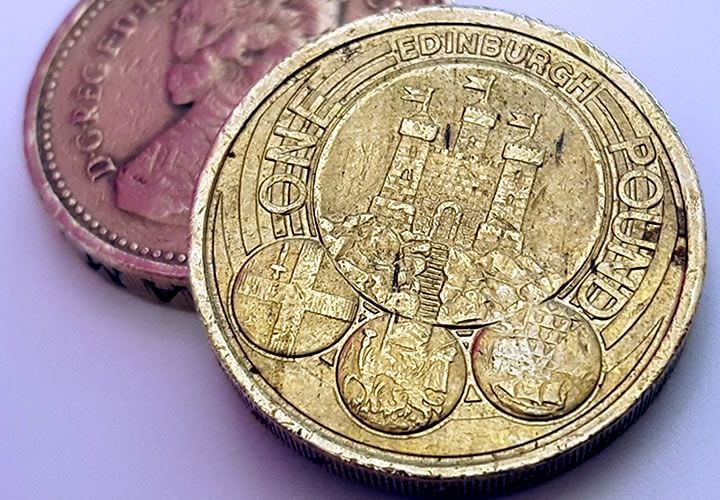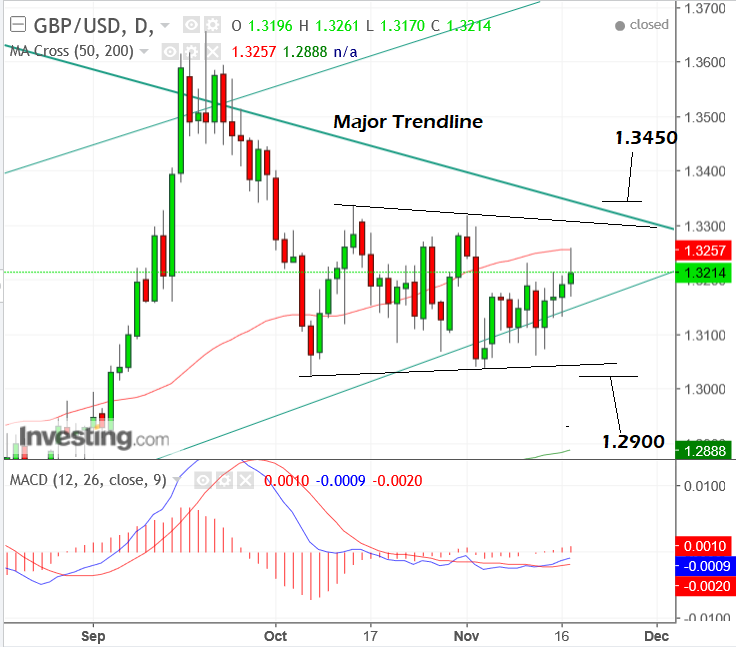Pound / Dollar: Technical Forecast, Events and Data to Watch in the Week Ahead

The Pound-to-Dollar exchange rate is likely to find gains hard to come by in the coming week unless the UK Chancellor is able to drop a well-received budget.
Pound Sterling is trading in a tight range against the US Dollar, being quoted at 1.3204 on Monday morning.
From a technical perspective, there is evidence supporting an eventual break out in either direction, with little bias one way or another at this point in time.
The pair has been in a steady uptrend for just over a year and has reached the major trendline drawn from the 2014 highs.

On touching the trendline in September sellers entered the market ensuring the exchange rate recoiled and pulled back down into the rangebound consolidation where it is currently trading, between 1.3030 and 1.3340.
If we look at the following graph, we will note the same trendline could come into play again in the near-term, but of course it is lower now than it was back in September:

The pair has just recovered after falling to the 1.3030 range floor and is currently trading at 1.3215 - there is a possibility it could continue rising within the range, however balanced against that is the fact the 50-day moving average (MA) is directly above the current market level and is likely to act as a significant obstacle to further gains.
If it manages to break above the 50-day MA, the range highs and also above the major trendline it will have established a strong basis for a continuation of the uptrend higher.
A break above a major trendline is a strong bullish indicator, however, a move above the 1.3350 level would be required to confirm such an extension, which would be expected to lead to a target at 1.3450.
Alternatively, a break below the range lows would probably signal a continuation down to a target at 1.2900, just above the 200-day moving average.
Such a move would gain confirmation from a move below the 1.3027 lows.
"An interesting bout of strength within the current 1.3025 – 1.3340 range. Our short-term studies suggest the range should persist and therefore the upside is expected to be limited. While under 1.3340 our bias is for an eventual test below 1.30, with the 1.28 region the main support below," says Robin Wilkin, a technical strategist with Lloyds Bank.
Get up to 5% more foreign exchange by using a specialist provider by getting closer to the real market rate and avoid the gaping spreads charged by your bank for international payments. Learn more here.
Data and Events for the Dollar
It is a quiet week for US data, and the US public holiday Thanksgiving falls on Thursday, November 23, which means most traders in New York will be off on Friday too to bridge the weekend.
Rather than lead to sluggish trading, however, research shows that the Friday after Thanksgiving has a propensity to being highly volatile.
"Low liquidity makes it extremely easy to exacerbate the volatility that we have been seeing in the currency market. In 2007 and 2006, the EUR/USD’s trading range on the Friday after Thanksgiving was more than 3 times its trading range on Thanksgiving Day," says BK Asset Management Managing Director Kathy Lien.
The main news release will be the minutes of the last (November) Federal Open Market Committee (FOMC) meeting, at which the central bank convenes to decide whether to change interest rates or not.
Whilst analysts will be keen to see if the discussions contained shed any further light on the projected path of interest rates, minutes do not usually surprise and are not normally market moving.
"Markets all but fully expect a Dec rate hike, with around 1.5 hikes priced for 2018. Thus we expect the market to largely look past debates around Dec in the Nov FOMC minutes as old news," say TD Securities.
Federal Reserve Chairwomen Janet Yellen is also set to make a speech at 23.00 GMT on Tuesday, November 21, but again she is not expected to reveal any new information, although the risk is that the market will get a surprise in the form of a more pessimistic assessment, rather than the other way around.
On the hard data front, Durable Goods orders are out at 13.30 on Wednesday and November business activity data, in the form of Purchasing Manager Surveys (PMI) are out on Friday at 14.45.
The Manufacturing PMI is expected to show a rise to 54.9 in November from 54.6 in the previous month, and Services PMI to rise to 55.6 from 55.3 previously.
A strong rise in November PMI data will probably support the Dollar although expectations are already high for a December interest rate hike (circa 90%) so more strong economic data is unlikely to improve the chances any more than they already are.
Data and Events to Watch for the Pound

The most significant event of the week ahead is the Autumn Budget statement on Wednesday, November 22 which will prove important in terms of the credibility of the UK Government, and the economy's potential growth trajectory.
From a currency perspective, the stability of Theresa May's Government is key; markets like stability and recent months have shown the Government to be anything but.
The budget is often a 'danger time' for Governments as popular support has often proven to be attuned to the success of a budget - recall George Osborne's 'omni-shambles budget' of 2012 where support for the Cameron Government slipped notably on perceived policy blunders presented in that budget.
"It is critical not only for the Government’s self-imposed fiscal goals (2% deficit by 2021, balanced by mid-2020s) but the survival of May’s Govt. due to mounting political pressures domestically and around Brexit," says Tim Riddell at Westpac.
"A successful budget could relieve some pressures with a sound fiscal hand, support struggling parts of the population and strained public departments (NHS, education, security, et al,) and even allow for a firmer approach towards Brexit," says the analyst.
Also of importance to the Pound is whether the budget is growth-friendly or not - if it is, it could help strengthen the Pound.
There is a possibility the budget could include more generous public spending, especially on housing, and if so, this has the potential to boost the Pound.
Increased public spending tends to increase economic activity, which can generate growth, inflation, and then higher interest rates.
Higher interest rates tend to boost the Pound by attracting more capital inflows from foreign investors seeking somewhere to park their money where it will earn higher returns.
"The chancellor has come under increasing pressure to deliver a popular ‘big and bold’ budget that includes increased spending as a means of reviving spirits in the struggling and divided government," says a briefing from TD Securities.
The politics of Brexit could also continue to impact on Sterling as EU leaders are scheduled to meet to discuss whether progress in divorce proceedings has been sufficient to allow discussions to move on to the all-important future trade relationship.
"In the near term, UK politics will likely be the main driver of GBP. In fact, GBP’s reaction to UK politics and our Brexit stress tracker is rising again," says Yujiro Goto of the Global FX Strategy desk at Nomura.
Although the size of the divorce bill remains a key sticking point there are signs the two sides are moving closer to a middle ground following reports from EU council head Donald Tusk that he found recent discussion with Theresa May surprisingly positive.
Any announcement of an agreement or being close to an agreement on the divorce bill would be extremely positive for the Pound.
The main hard data release is public spending figures for October at 9.30 GMT on Tuesday, November 21.
Public Sector Net Borrowing which is the difference between what the government earns in revenue and what it spends is expected to rise to 6.6bn, however, recent results have generally undershot expectations and a lower-than-expected amount might support
Sterling marginally by providing the Chancellor with more room to manoeuvre in his budget on Thursday.
Get up to 5% more foreign exchange by using a specialist provider by getting closer to the real market rate and avoid the gaping spreads charged by your bank for international payments. Learn more here.









